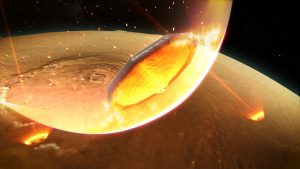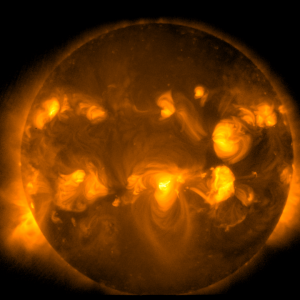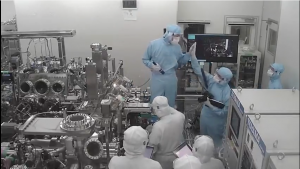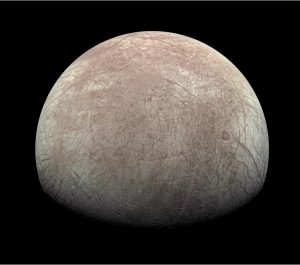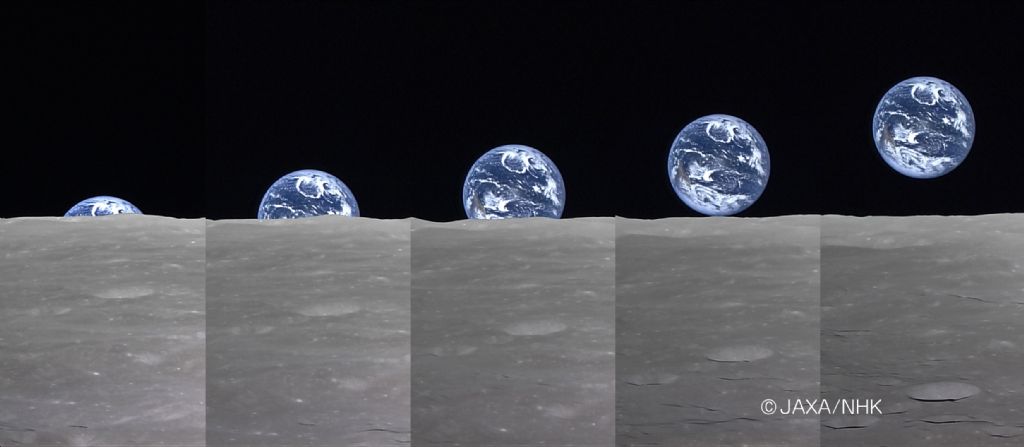
At the threshold of a lunar renaissance: The SELENE mission, 10 years later
(Dr Sarah Crites, one of our Top Young International Fellows (ITYF) reports on the symposium to celebrate 10 years since our SELENE mission to the Moon.)
On September 14, 2007, the SELENE mission launched from Tanegashima Space Center to begin its one-year mission to understand the Moon’s origin, history, and resource potential for human exploration. SELENE, also known as Kaguya, was the largest lunar mission since Apollo, carrying 15 scientific instruments and two small microsatellites. After release from the main spacecraft, which orbited at an altitude of 100 km, the microsatellites entered elliptical orbits to provide communications for SELENE and enable accurate measurement of the Moon’s gravity field. After one mission extension, SELENE’s time at the Moon finally ended when the spacecraft was guided to a planned impact onto the surface on June 11, 2009. However, SELENE’s measurements, scientific results, and international legacy have lasted far beyond the end of the active mission.
The continued relevance of the SELENE mission was demonstrated on September 13-15, 2017, when over 100 researchers from 6 countries gathered at Waseda University in Tokyo to attend the 2017 SELENE Symposium in honor of the 10th anniversary of the mission’s launch.
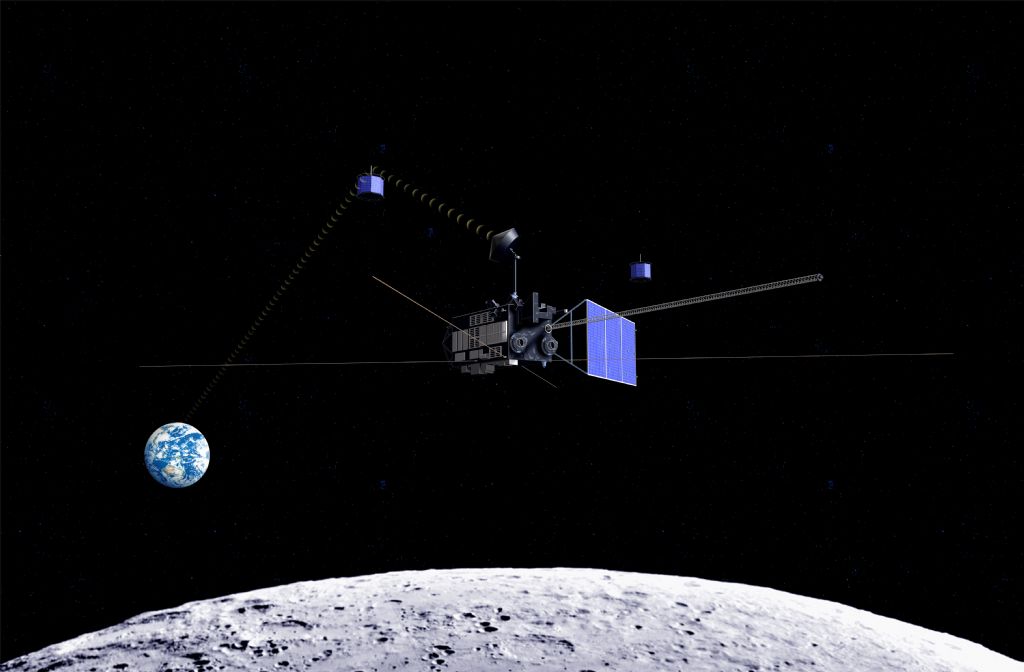
Artist impression of the SELENE/Kaguya Lunar orbiter, with its two microsatellites, above the surface of the Moon.
SELENE’s project managers Yoshisada Takizawa and Susumu Sasaki opened the symposium by sharing memories and lessons learned from the mission. Takizawa highlighted the critical importance of public outreach for science missions: the high definition television camera (HDTV) onboard SELENE, a collaboration between JAXA and the NHK national public broadcasting organization, took breathtaking video of Earthrise from the Moon and inspired great public support for the mission. Sasaki described the role that technology developed for SELENE, and the large team of scientists and engineers that worked on the mission, have played in developing the field of space and planetary science research in Japan. He cited the enthusiasm and energy of the mission team members together with strong technical support as key factors in ensuring SELENE’s success–and the success of JAXA’s numerous planetary science missions since.
The SELENE mission marked the beginning of a boom in planetary science research in Japan, but it also holds a unique position in the international community. After a relative lull in lunar missions lasting decades following the final Apollo mission, SELENE heralded a new renaissance in lunar exploration: its launch in 2007 was quickly followed by China’s Chang’e 1 later that same year, India’s Chandrayaan-1 in 2008, NASA’s Lunar Reconnaissance Orbiter in 2009, and a continued parade of orbiters, flyby missions, and one rover in the years since. Measurements from SELENE provided high-quality topography, illumination, and gravity maps that enabled many aspects of initial planning and scientific investigations for these subsequent missions, which together will lay the groundwork for human explorers to one day return to the Moon.

The SELENE mission logo.
As Earth’s celestial neighbor, the Moon is a key stepping-stone for human explorers as they expand deeper into the Solar System, and presentations at the SELENE Symposium highlighted some of the ways in which lunar science and human exploration can benefit one another. For example, NASA’s Brad Bailey described “the science of exploration as enabled by the Moon’s surface”, JAXA’s Takeshi Hoshino presented a conceptual framework for international human exploration of the Moon, and Google Lunar XPRIZE competitors Team Hakuto imagined the potential for one day building rocket fueling stations on the Moon. All of these presenters pointed towards understanding the quantity, type, and distribution of volatiles (including water) cold-trapped in lunar polar craters as a major priority for human exploration. If lunar natural resources can be processed to provide fuel, breathable air, and water, this could pave the way for a sustainable space-faring civilization. However, alongside these practical considerations, understanding the volatile deposits at the Moon’s poles is also of top priority for lunar scientists and could answer fundamental questions about solar system dynamics and the delivery of volatiles to the inner solar system and to Earth; a focus for both ISAS/JAXA Hayabusa2 and Martian Moons eXploration (MMX) missions.
Presentations about planned and conceptual future lunar missions further demonstrated the synergies between science and exploration. ISAS/JAXA are developing the Smart Lander for Investigating the Moon (SLIM), which has a provisional launch date in 2020. The mission will develop innovative pinpointed landing technology that will pave the way for future planetary missions to land with certainty in the best place to achieve mission goals and in more challenging terrain than ever before. Plans for SLIM also include a multiband imager instrument which will allow the mission to characterize local surface composition and geology, and contribute to our understanding of the lunar crust and mantle. A second mission in the pipeline is ISAS/JAXA OMOTENASHI, a lunar CubeSat which would launch with NASA’s Space Launch System (SLS) rocket. The mission, whose name means “hospitality”, would demonstrate the feasibility of extremely compact landing technology that will enable future missions; but OMOTENASHI will also carry a radiation monitor to characterize the lunar radiation environment, a topic of interest both for human explorers’ safety and to understand the fundamental science of space radiation.
The Apollo missions were the first to demonstrate the huge science returns possible from missions motivated by an interest in expanding humanity’s presence beyond Earth. Missions like SELENE have continued in this model, and the 2017 SELENE Symposium made it clear that the Moon remains a fascinating target for both science and exploration to the entire international community. As the symposium ended, the attendees were inspired to consider: What will we discover next together?
Scientific data from the SELENE mission is open to the public for scientific and educational use and can be accessed at the following URLs:
To explore the Moon with Kaguya images: [KAGUYA 3D GIS]
For PDS3-compatible web search: [Planetary Data System Search]
For PDS3 directory index access: [Directory]
For webGIS-based analysis and download: [KADIAS]
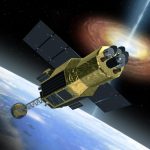 Previous Post
Previous Post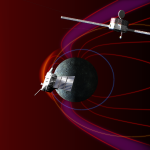 Next Post
Next Post